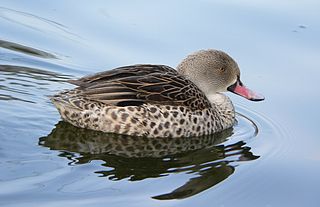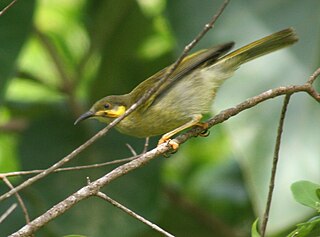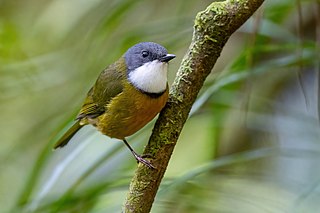
The Cape teal also Cape wigeon or Cape widgeon is a 44–46 cm long dabbling duck of open wetlands in sub-Saharan Africa.

The striated pardalote is the least colourful and most common of the four pardalote species. Other common names include pickwick, wittachew and chip-chip. It is a very small, short-tailed bird that is more often heard than seen, foraging noisily for lerps and other small creatures in the treetops.

The yellow bittern is a small bittern. It is of Old World origins, breeding in the northern Indian Subcontinent, east to the Russian Far East, Japan and Indonesia. It is mainly resident, but some northern birds migrate short distances. It has been recorded as a vagrant in Alaska and there is a single sighting in Great Britain, from Radipole Lake, Dorset on November 23, 1962 – however, the British Ornithologists' Union has always considered this occurrence to be of uncertain provenance and currently it is not accepted onto the official British List.

The watercock is a waterbird in the rail and crake family, Rallidae that is widely distributed across Southeast Asia. It is the only member of the genus Gallicrex.

The South African shelduck or Cape shelduck is a species of shelduck, a group of large goose-like birds which are part of the bird family Anatidae, which also includes the swans, geese and ducks. This is a common species native to southern Africa.

The red-billed teal or red-billed duck is a dabbling duck which is an abundant resident breeder in southern and eastern Africa typically south of 10° S. This duck is not migratory, but will fly great distances to find suitable waters. It is highly gregarious outside the breeding season and forms large flocks.

The New Zealand king shag, also known as the rough-faced shag, king shag or kawau, is a rare bird endemic to New Zealand. Some taxonomic authorities, including the International Ornithologists' Union, place this species in the genus Leucocarbo. Others place it in the genus Phalacrocorax.

The African rail is a small wetland bird of the rail family that is found in eastern and southern Africa.

The Cape spurfowl or Cape francolin is a gamebird in the pheasant family Phasianidae. It is endemic to southern Africa, where it is the largest francolin. It occurs in the Western Cape province of South Africa, and locally northwards to southern Namibia. It has adapted to alien vegetation and a variety of human-altered habitats, but scrubby roosting and nesting space is a prerequisite. The species is not threatened.

The tomtit is a small passerine bird in the family Petroicidae, the Australasian robins. It is endemic to the islands of New Zealand, ranging across the main islands as well as several of the outlying islands. In Māori, the North Island tomtit is known as miromiro and the South Island tomtit is known as ngirungiru. This bird has several other Māori and English names as well. There are several subspecies showing considerable variation in plumage and size. The species is not threatened and has adapted to the changes made to New Zealand's biodiversity.
The Polynesian storm petrel is a species of seabird in the family Oceanitidae. It is the only species placed in the genus Nesofregetta.

The large-billed tern is a species of tern in the family Laridae. It is placed the monotypic genus Phaetusa. It is found in most of South America. It has occurred as a vagrant in Aruba, Bermuda, Cuba, Panama and the United States. Its natural habitats are rivers and freshwater lakes.

The black-faced ibis is a species of bird in the family Threskiornithidae. It is found in grassland and fields in southern and western South America. It has been included as a subspecies of the similar buff-necked ibis, but today all major authorities accept the split. The black-faced ibis also includes the Andean ibis as a subspecies. Some taxonomic authorities still do so.

The Pacific imperial pigeon or lupe is a widespread species of pigeon in the family Columbidae. It is found in American Samoa, the Cook Islands, the smaller islands of eastern Fiji, Kiribati, Niue, the smaller satellite islands of Papua New Guinea, Samoa, Solomon Islands, Tokelau, Tonga, Tuvalu, Vanuatu, and Wallis and Futuna Islands.

The cinnamon attila is a species of bird in the family Tyrannidae, the tyrant flycatchers. It is found in northern South America in the Amazon Basin of Brazil and the Guianas. It is found in Brazil, Colombia, Venezuela, Guyana, Suriname, and French Guiana; also Amazonian Ecuador, Peru, and regions of Bolivia. Its natural habitat is subtropical or tropical swamps.

The Polynesian wattled honeyeater or the eastern wattled honeyeater, is a species of bird in the honeyeater family Meliphagidae. It was considered conspecific with the Fiji wattled honeyeater and the kikau.

The Jamaican becard is a species of bird in the family Tityridae. Its genus, Pachyramphus, has traditionally been placed in Cotingidae or Tyrannidae, but evidence strongly suggest it is better placed in Tityridae.

Parus is a genus of Old World birds in the tit family. It was formerly a large genus containing most of the 50 odd species in the family Paridae. The genus was split into several resurrected genera following the publication of a detailed molecular phylogenetic analysis in 2013. The genus name, Parus, is the Latin for "tit".

The Hawaiʻi ʻelepaio, also Hawaiian ʻelepaio, is a monarch flycatcher found on the Big Island of Hawaii. Until 2010, all three ʻelepaio species, the Kauaʻi ʻelepaio, the Oʻahu ʻelepaio and this species were considered conspecific.

The New Caledonian whistler is a species of bird in the family Pachycephalidae. It is endemic to New Caledonia.




















